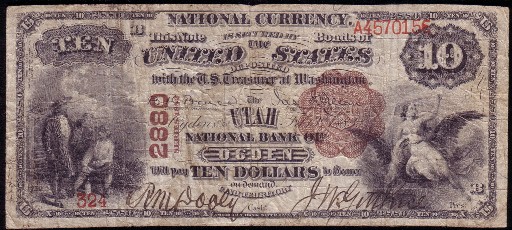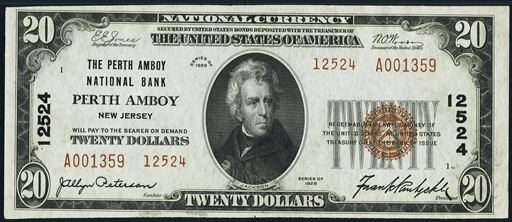The Southern National Bank Of Wynnewood
The Southern National Bank Of Wynnewood in Oklahoma printed $449,490 dollars worth of national currency. That is a pretty standard output. However, some types of currency from this bank could still be rare. This national bank opened in 1901 and stopped printing money in 1934, which equals a 34 year printing period. That is a fairly normal lifespan for a national bank. During its life, The Southern National Bank Of Wynnewood issued 10 different types and denominations of national currency. We have examples of the types listed below. Your bank note should look similar. Just the bank name will be different. For the record, The Southern National Bank Of Wynnewood was located in Garvin County. It was assigned charter number 5731.
We buy all national currency. Please call or email us for a quote. Sales@AntiqueMoney.com
The Southern National Bank Of Wynnewood in Oklahoma printed 960 sheets of $10 1882 territorial brown back national bank notes. A print run under 1,000 will get the attention of most people. Combine that with a territorial and you have a real winner. The ten dollar 1882 territorial brown back was printed by more than 200 national banks, and more than 200 pieces are known to exist today. That number tends to go up by a handful each year as more are discovered. Often times the $10 territorial was the first and lowest denomination a bank received. About a dozen #1 specimens are held by collectors today, and there are probably many more still held by descendants of early pioneer bankers. Territorial bank notes are the cream of the crop when it comes to national bank notes. Most are at least rare and some can be very valuable. As always, the exact value is still based on bank of issue and condition. Something ugly from Oklahoma might only be worth $3,000, but other examples could be worth well over $10,000.
Series of 1882 $10 Territorial Brown Back
The Southern National Bank Of Wynnewood printed 960 sheets of $10 1882 territorial brown back national bank notes. A print run under 1,000 will get the attention of most people. Combine that with a territorial and you have a real winner. The ten dollar 1882 territorial brown back was printed by more than 200 national banks, and more than 200 pieces are known to exist today. That number tends to go up by a handful each year as more are discovered. Often times the $10 territorial was the first and lowest denomination a bank received. About a dozen #1 specimens are held by collectors today, and there are probably many more still held by descendants of early pioneer bankers. Territorial bank notes are the cream of the crop when it comes to national bank notes. Most are at least rare and some can be very valuable. As always, the exact value is still based on bank of issue and condition. Something ugly from Oklahoma might only be worth $3,000, but other examples could be worth well over $10,000.
Series of 1882 $10 Territorial Brown Back
The Southern National Bank Of Wynnewood also printed 300 sheets of $10 1882 brown back national bank notes. Very few national banks issued such a small number of 1882 brown backs. There were three $10 bills printed on a single sheet of 1882 brown backs. The design of the bill is similar to all earlier ten dollar national bank notes. The nickname comes from the fact that these bills have a brown seal and brown overprint. Despite saying series of 1882, these were actually printed by some banks up until 1908. The date you see in cursive relates to when the bank first started issuing brown back notes.
Series of 1882 $10 Brown Back
The Southern National Bank Of Wynnewood also printed 300 sheets of $20 1882 brown back national bank notes. As you can see, the sheet output is the same for $20 brown backs as it is for $10 brown backs. There was only one $20 brown back printed on a sheet. So the sheet output also equals the total note output. One neat thing about all brown backs is that they each have a different back design based on which state issued them. The back left hand side of the note shows the state seal of which ever state the national bank was located in. Generally speaking, 1882 $20 brown backs are pretty difficult to locate. They typically were printed in small numbers and they don’t have a great survival rate.
Series of 1882 $20 Brown Back
The Southern National Bank Of Wynnewood also printed 3,302 sheets of $10 1882 blue seal national bank notes. That is a pretty standard sheet output number for these issues. Most of the value is going to be in the condition. All of these notes say series of 1882 but they were actually printed between 1908 and 1921. So they aren’t quite as old as the dates might suggest. There is also a date on these notes that is between 1888 and 1901. That date is written in cursive text and it represents when the bank was chartered or re-chartered. Some of the so called 1882 value back notes have a chance to be really rare. Most of the earlier notes that say 1882-1908 on the back are likely going to be relatively common. The designs are exactly the same on the front. Each has a blue seal and charter number.
1882 Blue Seal $10 National Bank Note
The Southern National Bank Of Wynnewood also printed 3,302 sheets of $20 1882 blue seal national bank notes. That is the same number of sheets as the ten dollar denomination. You don’t have to multiply by three to get the exact number of notes issued though. There was only one twenty dollar bill per sheet. As with any national bank note, the exact value is still based on the condition, serial number, and bank of issue.
1882 Blue Seal $20 National Bank Note
The Southern National Bank Of Wynnewood also printed 732 sheets of Type1 1929 $10 national bank notes. This is a small print range, but it does not guarantee rarity. Each $10 bill from 1929 has a portrait of Alexander Hamilton on it. The black number written vertically is the charter number. The charter number never affects the value; it is just an identifier. The ten dollar type1 national bank note happens to be the single most common national bank note, with over 65,000 known to exist from all banks. Of course each note is valued based on its condition and rarity. Some are very rare.
Series of 1929 Type1 $10 National Bank Note
The Southern National Bank Of Wynnewood also printed 184 sheets of Type1 1929 $20 national bank notes. That is an extremely small sheet printing number. Survivors are still likely but definitely not guaranteed. Andrew Jackson is featured on the front of each 1929 $20 bill. Be sure to take note of the serial number on your specific bank note. If it is 000001 then you can expect a nice premium. There is a special market for serial number one bank notes. Of course, even if the number isn’t #1, it could still be collectible and have a high value just based on its condition and rarity alone.
Series of 1929 Type1 $20 National Bank Note
The Southern National Bank Of Wynnewood also printed 280 individual notes from the type2 1929 $10 national bank note series. Type2 1929 national bank notes are already rare to begin with. A printing of less than 1,000 is especially low. The easiest way to spot the difference between type1 1929 $10 bills and 1929 type2 $10 bills is in the serial number. Type2 notes have a serial number that ends with a number. 1929 type1 notes have a serial number that ends with the letter A. Generally speaking, these $10 bills are rarer than the earlier type1 issues. However, most collectors don’t pay more for that rarity because they look basically the same.
Series of 1929 Type2 $10 National Bank Note
The Southern National Bank Of Wynnewood also printed 72 individual notes from the type2 1929 $20 national bank note series. Type2 1929 national bank notes are already rare to begin with. A printing of less than 1,000 is especially low. One of the great things about 1929 type2 $20 national bank notes is that they really aren’t that old and some can be extremely rare. Until the big head $20 series started there really wasn’t much difference between something printed in 1929 and the same bill printed in 1993. We have bought some examples in the past few months that people just found in their change.
Series of 1929 Type2 $20 National Bank Note



